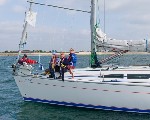 Go to main content
Go to main content
Archive Website of the UK government
Please note that this website has a UK government accesskeys system.
Main menu
Page menu
Travel and transport

Pleasure craft – safety equipment

It's sensible for all boats to carry safety gear but pleasure craft over 13.7 metres long must carry certain life-saving and fire safety equipment. Find out what your boat should have on board for any voyage.
Know what life-saving equipment you must carry on board
Life-saving signals
You must carry a copy of the recognised life-saving signals on board your boat, whatever its size
You must carry certain life-saving equipment on board if your pleasure craft is more than 13.7 metres long. This equipment includes:
- lifejackets
- life rafts
- flares
- fire extinguishers
There are regulations stating what you need depending on how big your boat is and how far you are travelling away from the coast.
These requirements are set out in detailed guidance from the Maritime and Coastguard Agency (MCA).
Make sure everyone on board has the right lifejacket
If your boat is more than 13.7 metres long, you must carry lifejackets for everyone on board, including any children. Even if it's not required by law, it's sensible for everyone to wear a lifejacket in case anyone falls overboard.
If you're in charge of the boat, it's your responsibility to make sure your crew's lifejackets fit properly and they know:
- where the lifejackets are stored
- how to use them
You can buy various types of lifejackets - think about the water conditions and where you'll be going before you make a purchase.
For advice about choosing a suitable lifejacket, check the website of the Royal National Lifeboat Institution (RNLI).
Carry lifebuoys and a throwing line for emergencies
You must carry at least two lifebuoys if your boat is more than 13.7 metres long. Make sure they are mounted where they can be thrown quickly in an emergency.
Lifebuoys should be marked with your boat's name and come equipped with:
- an automatic light with a continuous beam or a strobe
- retro-reflective tape
- a drogue, which prevents drifting
The lifebuoy should be attached to a buoyant throwing line (at least 18 metres long). This brightly coloured line may be coiled inside a throwing sack with a loop or handle and can be tied the boat in an emergency. Practise throwing the line with your crew - it can be difficult to throw one accurately.
Get the right radio equipment
Having a maritime radio on board will help you communicate with the coastguard or another boat if you get into difficulty.
Flares
 Tips for using flares safely
Tips for using flares safely
Make sure you use flare safely by:
- firing flares slightly downwind so they reach a good height
- not firing flares near radio masts or superstructures, or if a helicopter is near by
Pleasure craft that are more than 13.7 metres long must carry at least:
- four red hand flares
- four white hand flares
- two orange smoke flares
- four parachute flares
Before your trip, show your crew where the flares are kept and make sure they understand the firing instructions. Store flares in a waterproof container and check them regularly.
If your flares are out of date or damaged, you must dispose of them properly and safely as soon as possible.
Take at least one inflatable liferaft on long voyages
You can hire life rafts - they are essential for long trips. You need to carry enough life rafts to hold at least the total number of people on board.
Your life raft should be regularly serviced and stowed where it's ready for immediate launching - not below deck or beneath other equipment.
See the MCA's guidance on how many life rafts your boat should carry and the standards they should meet.
Fire safety equipment for pleasure craft
If your pleasure craft is more than 13.7 metres long, you need to carry at least:
- four multi-purpose fire extinguishers (each with a minimum fire rating of 13A/113B) or a combination of smaller extinguishers with the equivalent fire rating
- a fire pump that can deliver one jet of water from a distance of six metres (the pump can be powered or hand powered)
- two fire buckets, made of metal, plastic or canvas, with lanyards (a rope attached to the bucket)
Maintain and check fire blankets and extinguishers regularly. Make sure your crew knows where this equipment is kept and how to use it.
Check the MCA's guidance on the standards that your fire safety equipment must meet.
First-aid and emergency repair kits
In case someone gets injured, make sure you carry a first-aid kit on board and someone is trained to use it.
Follow the link below for a guide to the items that go in a first-aid kit and how to use them.
Put together an emergency repair kit that includes things like:
- tools and a stainless steel knife
- a waterproof torch and batteries
- lubricant and sealant
- a glass reinforced plastic (GRP or 'fibreglass') repair kit
- bungs, heavy duty tape and rags
- link belting, spare fuel filters and pump impellers
More useful links
Useful contacts
Additional links
Register your boat with the coastguard

Join HM Coastguard's voluntary safety identification scheme - if you get into difficulty, the coastguard will have information about your boat to help identify you
 Facebook
Facebook Twitter
Twitter StumbleUpon
StumbleUpon Delicious
Delicious Reddit
Reddit